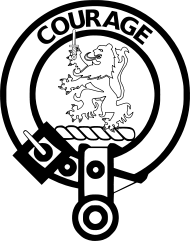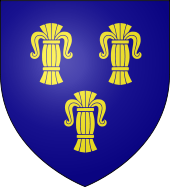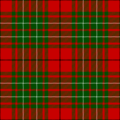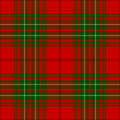- Clan Cumming
-
Clan Cumming or Comyn Crest badge 
Motto: Courage Slogan: An Cuimeanach! An Cuimeanach! War cry: Chad's bhios maide anns a' choill cha bhi foill an Cuimeanach Profile Region Highland & Lowland District Badenoch Plant badge Common Sallow (Salix cinerea) (the Pussy Willow)[1] Animal Lion Pipe music Willie Cumming's Rant Gaelic name Na Cuimeanaich (collective)
Cuimeanach (Singular)
Cuimean (Surname)
Na Cuimeanaich Clach na Cearc (Cummings of the Hen Stone)
Clann a'Ghaill (Children of the Lowlander)Chief

Sir Alexander "Alastair" Penrose Cumming of Altyre Seat Altyre, Moray, Scotland Historic seat Lochindorb Castle
Inverlochy CastleSepts of Clan Cumming or Comyn Bad(d)enoch, Buchan, Boghan, Chaney(ay), Chesney, Cheyne(y),Coman, Common(s), Comins, Comyn(s), Cowman(s), Cummin(s), Cummings, Landrum, Lendrum, MacCheine, MacCheyne(y), MacChesnie, MacCummin(s), MacCumming(s), MacNiven(s), MacSkimman(on), Niven(son), Nivison, Russell, Skimman(on) Clan branches Cumming of Altyre (chiefs)
Cumming of Culter
Cumming of Inverallochy
Cumming of Logie
Cumming of RegulasAllied clans Clan Wallace
Clan MacDougall
Clan Macdowall
Clan Sinclair
Clan Maxwell
Clan HayRival clans Clan Bruce
Clan GrantClan Cumming, also known as Clan Comyn, is a Scottish clan from the central Highlands that played a major role in the history of 13th century Scotland and in the Wars of Scottish Independence and were instrumental in defeating the English at the Battle of Roslin in 1303. The Clan Comyn were once the most powerful family in Scotland until however they were defeated in civil war by their rival to the Scottish throne, Robert the Bruce.
Contents
History
Origin of the clan
Like many of the families that came to power under King David I of Scotland, the Comyn clan is of Norman origin. The surname is either a place-name possibly derived from Comines, near Lille, in France[2][3], or possibly derived from Bosc-Bénard-Commin, near Rouen in the Duchy of Normandy.[4] Richard Comyn, the nephew of William Comyn, chancellor to King Henry I of England, is the one that established this family in Scotland. A later descendant was William Comyn, who married Marjory, Countess of Buchan. William's mother was Hextilda, the granddaughter of King Donald Bane of Scotland (Donald III). His son was Walter Comyn, the man who acquired the lordship of Badenoch. The seat of power was Ruthven Castle, located on the spot where now stands the remains of Ruthven Barracks. Ruthven Castle commanded the northern end of two passes over the Mounth, the Drumochter and Minigaig passes.[5] This lordship then passed to his nephew, the first John Comyn. This John was the first to be known as "the Red" Comyn. He was a descendant of William, Earl of Buchan, by his first wife, Sarah Fiz Hugh.
The chiefs also possessed the lordship of Lochaber. Here can be found the remains of Inverlochy Castle, built by the Comyns about 1270–1280.[6]
John "the Black" Comyn
The son of the first John Comyn was John II Comyn, Lord of Badenoch known as John "the Black" Comyn. He had a claim to the throne based on his descent from King Donald Bane. John was made one of the six guardians of Scotland after the death of King Alexander III, 1286. Their duty was to act as regents for Margaret of Norway, heir to the Scottish throne; however, she died en route to Scotland. King Edward I of England was asked to step in a decide who had the best claim to the crown of Scotland. He decided in favour of John Balliol. John had married Eleanor Balliol between 1270 and 1283.[7] The Black Comyn died at Lochindorb Castle in about 1303, a castle the Comyns built in the thirteenth century.[6]
John "the Red" Comyn
Wars of Scottish Independence
The son of the Black Comyn was John, known as the Red Comyn (John III Comyn, Lord of Badenoch). This John Comyn was both a descendant of King Donald III and King David I, as his maternal grandmother was Devorguilla of Galloway, the daughter of Margaret of Huntingdon. John Comyn married Joan de Valence. At this time the two main branches of the Clan Comyn were the Comyn Lords of Badenoch and Lochaber, and the Comyn Earls of Buchan.[8] They controlled key castles and therefore were the main lines of communication, especially in northern Scotland where their power stretched from Inverlochy Castle in the west to Slains Castle in the east.[9] Between these two points they had their power strategically situated in the following castles: Ruthven Castle, Lochindorb Castle, Blair Castle, Balvenie Castle, Dundarg Castle, Cairnbulg Castle, Castle of Rattray and Kingedward.[10] In particular Clan Comyn castles controlled important passes from the north and west highlands into the Tay basin.[11] A third main branch of the Clan Comyn, the Comyns of Kilbride, held power in southern and central Scotland. They held castles at Kirkintilloch (Dumbartonshire), Dalswinton (Nithsdale), Cruggleton Castle (Galloway), Bedrule, Scraesburgh (Roxburghshire), and Kilbride (East Kilbride).[12]
In addition to their private holdings the Clan Comyn also held a number of royal castles through their role as hereditary sheriffs of Dingwall at Dingwall Castle and Banff Castle (in the north) and Wigtown in the south west.[13] In the early 1290's the Clan Comyn also took additional responsibility for the royal castles at Kirkcudbright, Aberdeen Castle in Aberdeen, Jedburgh Castle, Clunie, Dull and Brideburgh.[14] Comyn influence over the political scene was further strengthened by marriages with the earls of Marr, Ross, Sngus, Strathearn and Fife, and with the powerful families of Clan MacDougall, Clan Murray, the Balliols, Mowbrays, Umphravilles and Soules.[15] Other prominent allies of the Comyns were the Clan Graham, Clan Fraser, Clan Sinclair, the Cheynes, Mowats, Lochores, Clan Maxwell and Clan Hay.[16]
The long standing authority of the Clan Comyn (Cumming) was witnessed by their extended tenure of the Justiciarship of Scotia, the most important political and administrative office in the kingdom. Three successive Comyn Lords of Badenoch and Earls of Buchan were justiciars of Scotia for no fewer than sixty six years between 1205 and 1304.[17] See: William Comyn, Lord of Badenoch and Alexander Comyn, Earl of Buchan.
After a succession of indignities toward Scotland, the Scottish people were forced into rebellion. John III Comyn, Lord of Badenoch, known as John "the red" Comyn was a leader in Scottish independence. With the outbreak of war between England and Scotland, Comyn, his father, and his cousin, John Comyn, Earl of Buchan, crossed the border and attacked Carlisle 26 March 1296, defended for King Edward by Robert Bruce, Earl of Carrick, the father of the future king.[18]
John Comyn became the most powerful political and military leader in Scotland from 1302 to 1304. He led the Scottish army against the English in the Battle of Roslin, 23 February 1303. John's greatly outnumbered army faced and beat the well-trained English army. However, many of the Red Comyn's allies made peace with King Edward, and so John submitted to King Edward at Strathhord on 9 February 1304.[19]
In 1306 John Comyn, Lord of Badenoch, and Robert Bruce met in the church of the Grey Friars, Dumfries. This resulted in John's murder on 10 February 1306.[20] Why this all came about is a matter of dispute. One account claims that the Bruce knew he had to gain the support of John Comyn; however, John was outraged when it was proposed he betray his terms with King Edward I.[21] It is likely that Robert Bruce stabbed the Red Comyn at the high altar and his companions finished the job.[22] Sir Robert Comyn, uncle to the Comyn chief, while defending of his nephew, was also killed. Both the Comyn chief titles as Lord of Badenoch and Earl of Buchan were fofeited to the crown.
John's son, also named John, was killed while leading his clan against the forces of Robert Bruce at the Battle of Bannockburn in 1314. The Comyns had also previously been defeated by Bruce at the Battle of Inverurie (1308). Any hopes of the Comyns returning to power ended at Bannockburn. Adomar Comyn, the son of John, died just two years later and was the last male of the Badenoch line. The lands in Badenoch, once the centre of Comyn power, were given to the Clan Macpherson for supporting Robert Bruce.[23]
14th, 15th & 16th century clan conflicts
The taking of Castle Grant, 14th century; Originally a Clan Comyn stronghold, Clan Grant traditions tell us that the castle was taken from the Comyns by a combined force of the Grants and MacGregors. The Grants and MacGregors stormed the castle and in the process slew the Comyn Chief – and kept the Chief's skull as a trophy of this victory. The skull of the Comyn was taken as a macabre trophy and was kept in Castle Grant and became an heirloom of the Clan. (In the late Lord Strathspey's book on the Clan, he mentions that the top of the cranium was hinged, and that he saw documents kept in it.) Clan tradition predicts grave things if the skull ever leaves the hands of the family – prophesying that the Clan would lose all of its lands in Strathspey.
At the beginning of the fifteenth century, Clan Comyn now known as Clan Cumming had been reduced to simply another Highland clan, although the clan continued to play a significant part in the history and culture of the Badenoch, Strathspey, and Aberdeenshire regions of Scotland.
In the fifteenth and sixteenth centuries, the Cummings carried on significant, and bloody, feuds with Clan Macpherson, Clan Shaw, and Clan Brodie over lands in Nairnshire. In 1550 Alexander Brodie, chief of Clan Brodie and 100 others were denounced as rebels for attacking the Cummings of Altyre.[24]
The Clan Cumming were victorious when they participated in the Battle of Glenlivet in 1594 in support of the Earl of Huntly whose forces consisted of 2000 Highlanders from Clan Gordon, Clan Cumming, Clan Cameron and others. Their enemy was the Earl of Argyll whose forces consisted of 10000 Highlanders from Clan Campbell, Clan Murray of Atholl, Clan Forbes, the Chattan Confederation of Clan MacKintosh and others. Huntly's forces were victorious.
During the late sixteenth and throughout the seventeenth century, members of the clan were known for their musical talents and served as the hereditary pipers and fiddlers to the Laird of Grant of Clan Grant.
The Clan Today
Many members of the Cumming (Comyn) clan left Scotland for greener pastures, some went to Ireland, England and Wales, others later migrated to America, Canada, Australia, South Africa and New Zealand. Due to the diffusion of the clan, the family name would change over time, today there are many different spellings of the name, however, the most common spellings include, the Scottish Cumming or Comyn, the Irish Cummins or O'Comyn, the English Cummings, as well as Cummin, Cummine and Cuming.
Chiefs and seat
After the death of the last chief in the Badenoch line, the chiefship fell on the Cummings of Altyre, and it is retained by this family to the present. The current Chief is Sir Alexander "Alastair" Penrose Cumming of Altyre, a descendant of Sir Robert Comyn, the knight who was killed while defending his nephew, John the Red Comyn.[25]
Tartans
Tartans associated with the surname Comyn/Cumming include :
Tartan Notes 
MacAulay or Comyn/Cumming: This tartan was first published by James Logan as a MacAulay tartan; it was illustrated in Logan and R. R. McIan's joint work The Clans of the Scottish Highlands in 1845. An almost identical tartan, listed as a Cymyne (Comyn) tartan, appeared in the 1842 work, Vestiarium Scoticum, by the infamous 'Sobieski Stuarts'.[26] By the 1850 work of W & K Smith it is listed as the Comyn/Cumming tartan.[27] The Smiths had claimed the tartan had the sanction of the head family of Cumming.[27] Scottish Tartans World Register#1157 
Comyn: This tartan was first published in 1842, in the Vestiarium Scoticum. The Vestiarium was composed and illustrated by the "Sobieski Stuarts". - Arms of the chief (Cumming): Azure, three garbs Or. Crest: A lion rampant Or holding in his dexter paw a dagger Proper. Motto: Courage. Supporters: Two horses Argent.[28][29]
- Arms of the Comyns of Buchan: Azure, three garbs Or.
- Arms of the Comyns of Badenoch: Gules three garbs Or.
- Arms of Gordon-Cumming: Quarterly, 1st & 4th, three garbs Or (Cumming); 2nd & 3rd, Argent, three bends Sable, each charged with as many roses of the field (Penrose); overall, in an escutcheon Argent, is placed the Arms, Crest, Motto and Supporters of Gordon of Gordonston
Castles
Clan Cumming was one of the leading castle-building families of Scottish history and are associated with many castles in Scotland, England, Ireland and Spain.
- Albiz Tower, Albiz, Spain
- Balvenie Castle, Moray, Scotland
- Bedrule Castle, Roxburgh, Scotland
- Blair Castle, Perth, Scotland
- Cadzow Castle, Lanark, Scotland
- Castle Grant, Inverness, Scotland
- Castle Roy, Inverness, Scotland
- Comyn's Castle, Strathclyde, Scotland
- Dalswinton Castle, Dumfries, Scotland
- Delgatie Castle, Aberdeen, Scotland
- Drum Castle, Aberdeen, Scotland
- Dumphail Castle, Moray, Scotland
- Dundarg Castle, Aberdeen, Scotland
- Ellon Castle, Aberdeen, Scotland
- Inchtalla Castel, Perth, Scotland
- Inverallochy Castle, Aberdeen, Scotland
- Inverlochy Castle, Lochaber, Scotland
- Kinedar Castle, Aberdeen, Scotland
- Kirkintilloch Castle, Strathclyde, Scotland
- Lochindorb Castle, Inverness, Scotland
- Loch-an-Eilein Castle, Inverness, Scotland
- Machan Castle, Lanark, Scotland
- Mains Castle, Dundee, Scotland
- Northallerton Castle, Northumberland, England
- Pittulie Castle, Aberdeen, Scotland
- Polkelly Castle, Fenwick, Scotland
- Rait Castle, Nairn, Scotland
- Ruthven Barracks, Inverness, Scotland
- Slains Castle, Aberdeen, Scotland
- Swords Castle, Dublin, Ireland
- Urquhart Castle, Inverness, Scotland
Religious sites
Clan Cumming is associated with these religious sites :
- Altyre Kirk, Moray, Scotland
- Cumbernauld Chapel, Lanark, Scotland
- Deer Abbey, Aberdeen, Scotland
- Glasgow Cathedral, Strathclyde, Scotland
- Inchmahome Priory, Perth, Scotland
See also
- Battle of the Pass of Brander
- Battle of Roslin
- Comyn (disambiguation)
- Cummins
- Cummings (disambiguation)
- Buchan
- Earl of Buchan
- John "the Black" Comyn
- John "the Red" Comyn
Notes and references
- ^ Anderson, William. The Scottish Nation; or, Surnames, Families, Literature, Honours, and Biographical History of the People of Scotland. Vol. 1 (Edinburgh and London: A. Fullarton & Co., 1877), 739. "The assumption of the badge of the cumin plant for the supposed clan, a plant that is only found in the region of Egypt, but which happens to be named in the Old Testament, is scarcely correct. It is rather the common sallow, a species of willow, that the Cummings have adopted as their clan badge."
- ^ MacKinnon, Charles. Scottish Highlanders. (New York: Barnes & Noble Books, 1984) 139.
- ^ Grant, Neil. Scottish Clans and Tartans. (Guilford, Connecticut: The Lyons Press, 2002) 58.
- ^ Alan Young, ‘Cumin , William (d. c.1160)’, Oxford Dictionary of National Biography, Oxford University Press, 2004.
- ^ Young, Alan. Robert the Bruce's Rivals: The Comyns, 1212–1314. 1997. (East Linton, Scotland: Tuckwell Press, 1998) 148.
- ^ a b Young, Alan. Robert the Bruce's Rivals: The Comyns, 1212–1314. 1997. (East Linton, Scotland: Tuckwell Press, 1998) 151.
- ^ Weis, Frederick Lewis. Ancestral Roots of Certain American Colonist Who Came to America before 1700. Eds. William R. Beall and Kaleen E. Beall. 8th ed. (Baltimore: Genealogical Publishing Company, 2004) 119.
- ^ Alan Young & Michael J Stead. "In the Footsteps of Wiliam Wallace, In Scotland and Northern England". Pages 44 - 45. ISBN: 978-0-7524-5638-6.
- ^ Alan Young & Michael J Stead. "In the Footsteps of Wiliam Wallace, In Scotland and Northern England". Pages 44 - 45. ISBN: 978-0-7524-5638-6.
- ^ Alan Young & Michael J Stead. "In the Footsteps of Wiliam Wallace, In Scotland and Northern England". Pages 44 - 45. ISBN: 978-0-7524-5638-6.
- ^ Alan Young & Michael J Stead. "In the Footsteps of Wiliam Wallace, In Scotland and Northern England". Pages 44 - 45. ISBN: 978-0-7524-5638-6.
- ^ Alan Young & Michael J Stead. "In the Footsteps of Wiliam Wallace, In Scotland and Northern England". Pages 44 - 45. ISBN: 978-0-7524-5638-6.
- ^ Alan Young & Michael J Stead. "In the Footsteps of Wiliam Wallace, In Scotland and Northern England". Pages 44 - 45. ISBN: 978-0-7524-5638-6.
- ^ Alan Young & Michael J Stead. "In the Footsteps of Wiliam Wallace, In Scotland and Northern England". Pages 44 - 45. ISBN: 978-0-7524-5638-6.
- ^ Alan Young & Michael J Stead. "In the Footsteps of Wiliam Wallace, In Scotland and Northern England". Pages 44 - 45. ISBN: 978-0-7524-5638-6.
- ^ Alan Young & Michael J Stead. "In the Footsteps of Wiliam Wallace, In Scotland and Northern England". Pages 44 - 45. ISBN: 978-0-7524-5638-6.
- ^ Alan Young & Michael J Stead. "In the Footsteps of Wiliam Wallace, In Scotland and Northern England". Pages 44 - 45. ISBN: 978-0-7524-5638-6.
- ^ Young, Alan. Robert the Bruce's Rivals: The Comyns, 1212–1314. 1997. (East Linton, Scotland: Tuckwell Press, 1998) 157
- ^ Young, Alan. Robert the Bruce's Rivals: The Comyns, 1212–1314. 1997. (East Linton, Scotland: Tuckwell Press, 1998) 186.
- ^ Weis, Frederick Lewis. Ancestral Roots of Certain American Colonist Who Came to America before 1700. Eds. William R. Beall and Kaleen E. Beall. 8th ed. (Baltimore: Genealogical Publishing Company, 2004) 92.
- ^ Young, Alan. Robert the Bruce's Rivals: The Comyns, 1212–1314. 1997. (East Linton, Scotland: Tuckwell Press, 1998) 198.
- ^ Young, Alan. Robert the Bruce's Rivals: The Comyns, 1212–1314. 1997. (East Linton, Scotland: Tuckwell Press, 1998) 197.
- ^ MacKinnon, Charles. Scottish Highlanders. (New York: Barnes & Noble Books, 1984) 213.
- ^ Bain, George, F.S.A., Scotland (1893). P. 230. History of Nairnshire. Nairn, Scotland: Nairn Telegraph Office.
- ^ "burkes-peerage.net – GORDON CUMMING OF ALTYRE, CHIEF OF CUMMING". http://www.burkes-peerage.net/familyhomepage.aspx?FID=0&FN=GORDONCUMMING.
- ^ Stewart & Thompson & Scarlett, p. 54.
- ^ a b Stewart, pp.47, 67.
- ^ Way, George, and Romilly Squire. Scottish Clan & Family Encyclopedia. (New York: Barnes & Noble Books, 1998) 376.
- ^ Cruikshank Roger, James. Rothesay Castle and the Rothesay Tombs. (Privately Printed, 1896) 26. "...the bearings of the Cummings being three garbs or wheat-sheaves."
External links
Scottish clans Clans with chiefs Agnew · Anstruther · Arbuthnott · Arthur · Bannerman · Barclay · Borthwick · Boyd · Boyle · Brodie · Broun · Bruce · Buchan · Burnett · Cameron · Campbell · Carmichael · Carnegie · Cathcart · Charteris · Chattan · Chisholm · Cochrane · Colquhoun · Colville · Cranstoun · Crichton · Cumming · Darroch · Davidson · Dewar · Drummond · Dunbar · Dundas · Durie · Elliot · Elphinstone · Erskine · Farquharson · Fergusson · Forbes · Forsyth · Fraser · Fraser of Lovat · Gayre · Gordon · Graham · Grant · Gregor · Grierson · Guthrie · Haig · Haldane · Hamilton · Hannay · Hay · Henderson · Home · Hope · Hunter · Irvine · Jardine · Johnstone · Keith · Kennedy · Kerr · Kincaid · Lamont · Leask · Lennox · Leslie · Lindsay · Lockhart · Lumsden · Lyon · MacAlister · MacBain · MacDonald · Macdonald of Clanranald · MacDonald of Keppoch · Macdonald of Sleat · MacDonell of Glengarry · MacDougall · Macdowall · MacIntyre · Mackay · Mackenzie · Mackinnon · Mackintosh · Maclachlan · Maclaine of Lochbuie · MacLaren · MacLea (Livingstone) · Maclean · MacLennan · MacLeod · MacLeod of Lewis · MacMillan · Macnab · Macnaghten · MacNeacail · MacNeil · Macpherson · MacTavish · MacThomas · Maitland · Makgill · Malcolm (MacCallum) · Mar · Marjoribanks · Matheson · Menzies · Moffat · Moncreiffe · Montgomery · Morrison · Munro · Murray · Napier · Nesbitt · Nicolson · Ogilvy · Oliphant · Primrose · Ramsay · Rattray · Riddell · Robertson · Rollo · Rose · Ross · Ruthven · Sandilands · Scott · Scrymgeour · Sempill · Shaw · Sinclair · Skene · Spens · Stirling · Strange · Stuart of Bute · Sutherland · Swinton · Trotter · Urquhart · Wallace · Wedderburn · Wemyss · Wood ·
Armigerous clans Abercromby · Abernethy · Adair · Adam · Aikenhead · Ainslie · Aiton · Allardice · Anderson · Armstrong · Arnott · Auchinleck · Baillie · Baird · Balfour · Bannatyne · Baxter · Bell · Belshes · Bethune · Beveridge · Binning · Bissett · Blackadder · Blackstock · Blair · Blane · Blyth · Boswell · Brisbane · Buchanan · Butter · Byres · Cairns · Calder · Caldwell · Callender · Campbell of Breadalbane · Campbell of Cawdor · Carruthers · Cheyne · Chalmers · Clelland · Clephane · Cockburn · Congilton · Craig · Crawford · Crosbie · Cunningham · Dalmahoy · Dalrymple · Dalzell · Dennistoun · Don · Douglas · Duncan · Dunlop · Edmonstone · Fairlie · Falconer · Fenton · Fleming · Fletcher · Forrester · Fotheringham · Fullarton · Galbraith · Galloway · Gardyne · Gartshore · Ged · Gibsone · Gladstains · Glas · Glen · Glendinning · Gray · Gunn · Haliburton · Halkerston · Halket · Hepburn · Heron · Herries · Hogg · Hopkirk · Horsburgh · Houston · Hutton · Inglis · Innes · Kelly · Kinloch · Kinnaird · Kinnear · Kinninmont · Kirkcaldy · Kirkpatrick · Laing · Lammie · Langlands · Learmonth · Little · Logan · Logie · Lundin · Lyle · MacAulay · Macbrayne · MacDuff · MacEwen · MacFarlane · Macfie · Macgillivray · MacInnes · MacIver · Mackie · MacLellan · Macquarrie · Macqueen · Macrae · Masterton · Maule · Maxton · Maxwell · McCorquodale · McCulloch · McKerrell · Meldrum · Melville · Mercer · Middleton · Moncur · Monteith · Monypenny · Mouat · Moubray · Mow · Muir · Murray of Atholl · Nairn · Nevoy · Newlands · Newton · Norvel · Ochterlony · Orrock · Paisley · Paterson · Pennycook · Pentland · Peter · Pitblado · Pitcairn · Pollock · Polwarth · Porterfield · Preston · Pringle · Purves · Rait · Ralston · Renton · Roberton · Rossie · Russell · Rutherford · Schaw · Seton · Skirving · Somerville · Spalding · Spottiswood · Stewart · Stewart of Appin · Strachan · Straiton · Strange · Sydserf · Symmers · Tailyour · Tait · Tennant · Troup · Turnbull · Tweedie · Udny · Vans · Walkinshaw · Wardlaw · Watson · Wauchope · Weir · Whitefoord · Whitelaw · Wishart · Young
Culture and society Scotland · Clan chief · Septs · Clan badge · Clan crest · Clan battles · Tartan · Bagpipes · Clearances · Kilt · Manrent · The Highlands · Battle of Culloden · Highland games · Border Reivers · Scottish heraldry · Scottish surnames
Categories:- Clan Comyn
- Scottish clans
Wikimedia Foundation. 2010.


